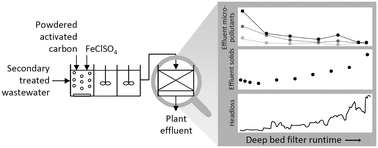Characterizing solids retention, head loss development and micropollutant removal in the case of direct powdered activated carbon dosage upstream of deep bed filtration†
Abstract
Removing micropollutants from wastewater is an issue of increasing interest, as many of these substances may pose a risk to aquatic environments. One process option for micropollutant elimination is adsorption onto powdered activated carbon (PAC) and subsequent PAC separation by dual media deep bed filtration. In this study, large- and pilot-scale experiments were performed to study the solids retention, head loss development and micropollutant removal in this process set-up. A particular focus was placed on the dynamic behavior in the course of a filtration cycle and solids breakthrough after long filter runtimes. In three measuring campaigns, the effluent of three filters (expanded shale, expanded clay and anthracite) was analysed for standard parameters, 11 organic micropollutants, microparticle counts, and for PAC using a selective thermogravimetric detection method. The removal efficiency was 92–95% for total suspended solids and >98% for PAC in particular. The results of this study will support efficient plant design and operation and, thereby, help minimize PAC leakage into the environment.



 Please wait while we load your content...
Please wait while we load your content...